Choosing the Right Running Shoe for Foot Types & Running Styles
Running is one of the highest impact and intensity forms of physical exercise, regardless of its apparent simplicity. When you run, your body experiences shock created by the impact of your feet striking the ground. If you don’t have any proper foundation in your feet, this force puts a considerable strain on your joints. That’s why it is essential to pick the right running shoes because they provide the necessary foundation, absorbing body weight and this high-impact force.
In this guide, we’ll discuss how to choose running shoes for foot types and running styles, as well as explain which features to look for when shopping.
Choosing Running Shoes for Foot Types
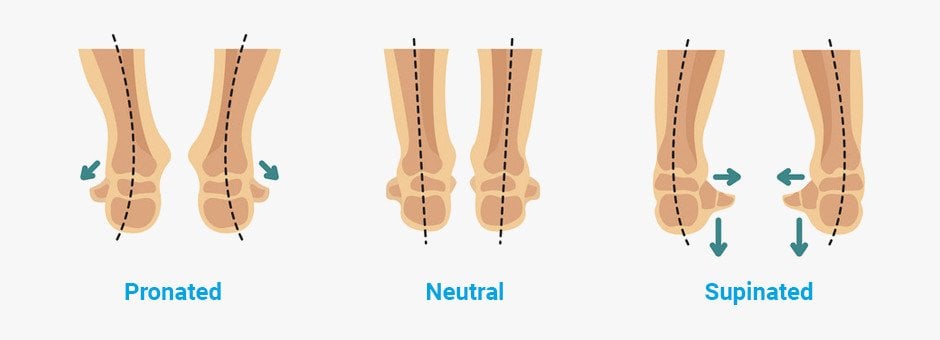
Pronation
We all have different bodies moving in their own unique ways. So when choosing sneakers for running, you need to analyze your gait (aka a manner of running), most importantly, your pronation type.
Pronation describes how your foot lands and rolls upon impact with the ground when cushioning your landing. Basically, it’s a rotational movement happening in the ankle joint, due to which we can see a certain angle between the ankle and the heel. Knowing your pronation type and degree, you’ll be able to pick a pair of sneakers with compensating support and features that reduce excess movement and promote more even weight distribution.
Pronation types include neutral pronation (also known as basic or normal), overpronation, and supination.
- A neutral type of pronation is when your foot rolls slightly inward. It’s the most biomechanically efficient movement that allows for even weight distribution and shock absorption. Consequently, natural pronators have the least risk of experiencing shock-related injuries.
- Overpronation, also known as excess pronation, is when your foot rolls inward too much. Exaggerated inward rolling at the ankle (beyond neutral 15 degrees) and excessive flexibility of the foot produce a higher risk of injuries caused by your foot’s inner edge taking more impact. Overpronators also have flat feet or low arches.
- Supination (or underpronation) is when your foot rolls outward and causes you to land more on the outer part. The negatives of such movement include increased strain on the ankle and lower leg and increased risk of injuries. Stiffer feet and high arches are characteristic of supinating runners.
So how do you determine your type of pronation? You can turn to a specialist, examine wear patterns in your old running shoes, or do both. If you’re a beginner runner, expert advice is absolutely required. You can book an appointment with a medical professional or come to the RunUnited store and ask a store assistant for help. We have the necessary equipment for gait analysis, and the only thing needed from you is to run on a treadmill a little. An assistant will take a video of you running, tell you your pronation type and other insights, and recommend an appropriate pair of running shoes.
Don’t be shy to ask questions and share information you deem important in the context of running shoes. Gait analysis is a powerful tool, but it’s not everything. Share your injury history and running history, if any.
Checking for Wear & Tear on Running Shoes
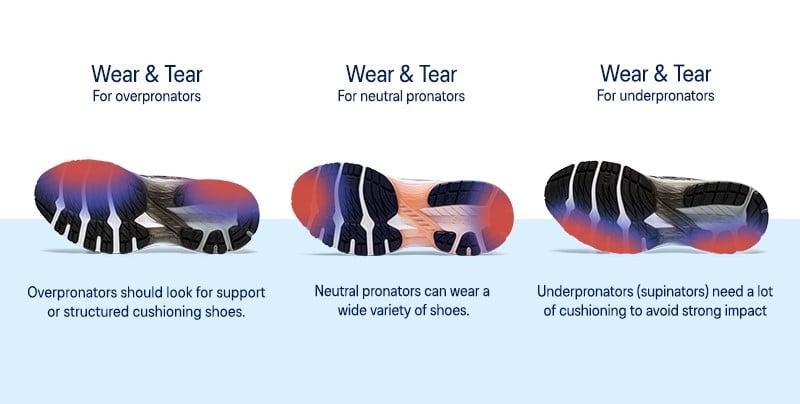
Your retiring running shoes and long-worn walking shoes (in case you’ve never run for training or fun before) are also goldmines of information. So another way to determine your pronation type is to check wear patterns on your shoes. They won’t tell you everything but can provide additional information on how your feet hit the ground.
- Neutral Pronation. Wear patterns are S-shaped, meaning you’ll see the most wear in the big toe, center of the ball, and lateral heel.
- Overpronation. Wear is concentrated along the inside edge, specifically, the big toe, under the ball, and inside the heel. If you overpronate, your shoes will tilt inward when placed on a flat surface.
- Supination. In contrast to overpronation, you’ll see a lot of wear along the outside edge, and your shoes will tilt outward.
Remember, in most cases, overpronation and supination are not conditions to be addressed. But you need to account for your pronation type for injury prevention.
Types of Running Shoes by Arch Support Level
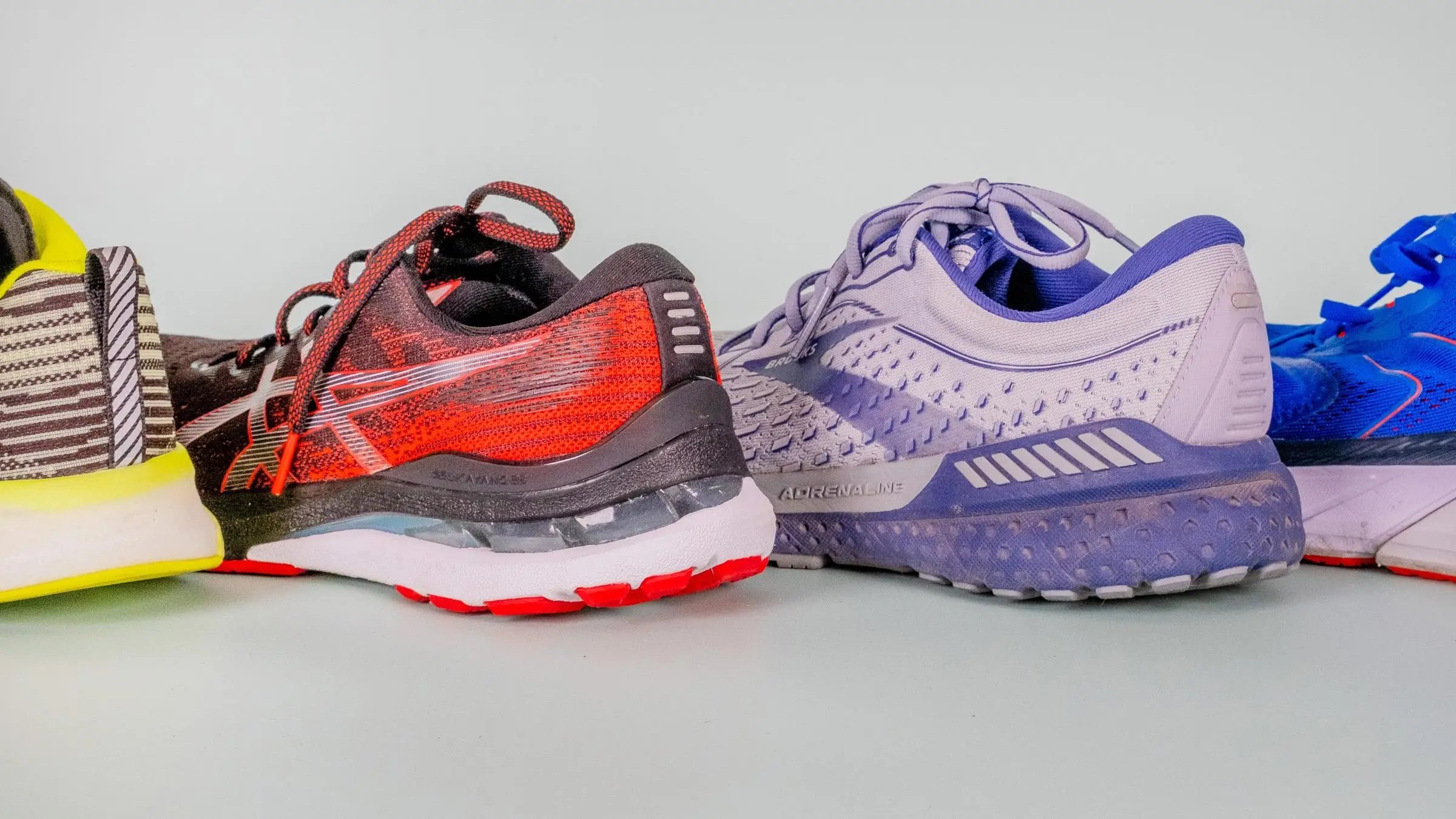 All running shoes fall into one of three categories: neutral shoes, stability shoes, and motion control shoes. Now, this information isn’t labeled on the shoe or box, but once you know the difference in the build, you’ll be able to tell one from another.
All running shoes fall into one of three categories: neutral shoes, stability shoes, and motion control shoes. Now, this information isn’t labeled on the shoe or box, but once you know the difference in the build, you’ll be able to tell one from another.
Motion Control Running Shoes
This type is perfect for moderate and severe overpronators with flat feet or low arches because it offers maximum support. Motion-control shoes are characterized by a rigid heel counter that prevents the heel from rotating excessively inside the shoe, minimal to no twist side-to-side, and pronounced medial posts for maximum reinforcement in the arch side. These shoes won’t bend in the middle, showing a little flex only in the toe section.
Stability Running Shoes
This type is built to compensate for mild and moderate overpronation. Everything is less stiff in these shoes compared to the motion-control design. The heel counter is softer, there’s a little more side-to-side twist, and the shoe is more bendable while remaining rigid in the midfoot. There’s also a bit less extra material in the inside arch.
Neutral Running Shoes
Best for neutral runners, this type will also suit mild overpronators and supinators. Neutral shoes are a lot more flexible than the other two shoe designs and lack that extra arch material on the inside edge.
Read: Stability Neutral Running Shoes: Guide + Best Picks
Choosing Running Shoes for Running Style
Foot Strike: Heel Strike, Midfoot Strike, Forefoot Strike
While pronation is more about whether it is the inside or outside of your foot that hits the ground, foot strike is about whether it is the front or the rear part of your foot that makes contact with the floor. The topic of which foot strike pattern is better is often the point of hot debates, but we won’t touch on it here because we want to talk about running sneakers. Let’s just state that all three patterns are popular with recreational and elite runners to some extent. Interestingly, the absolute majority of recreational runners are heel strikers, while midfoot and rearfoot strike patterns rule with serious runners.
Heel strikers hit the ground with their heel first before the rest of the foot, so the most load goes there. The Achilles tendon, on the other hand, isn’t actively engaged. This pattern is often correlated with overstriding when the front leg extends too far in front of the body. While overstriding is a mistake, heel striking in itself is not. If you have no knee or other pain after a run, you might be a natural heel striker, so there’s nothing to worry about.
Midfoot striking is, obviously, when the middle of the foot makes first contact with the ground. It’s considered the most efficient style because body weight is distributed more evenly across the ankles, knees, hips, and back.
If it’s the ball of the foot that lands first, then it’s forefoot striking. The heel may not touch the ground at all. The forefoot strike pattern is effective for sprints and short-speed bursts but is not good for long-distance runners because of the additional strain it puts on the toes and calf muscles.
It’s noteworthy that no pattern guarantees injury-free running. Heel strikers may be prone to knee and hip pain, while midfoot and forefoot runners may suffer from ankle or Achilles tendon pain. You may change your pattern, though. Just do it gradually and only because you feel it will benefit you, not because the internet says.
Now, let’s consider several features and how they must be mixed up in the shoes to provide the best running experience.
Heel-to-Toe Drop & Cushioning
Otherwise known simply as heel drop, the term refers to the difference between the thickness of the shoe’s sole at the heel and the forefoot.
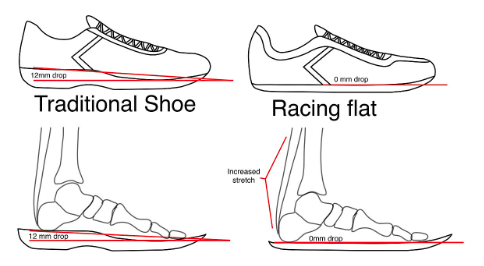
Traditionally, most running sneakers are made for heel strikers because it’s what most runners are. That’s why higher-drop models are more frequent - a thicker, more cushioned heel absorbs more shock generated by the foot landing on the heel and protects it. It doesn’t mean, however, that heel strikers don’t love low-drop shoes because some do. A lower drop means less cushioning, and some runners prefer to feel their connection to the ground.
Midfoot and forefoot strikers, on the other hand, prefer lower-drop shoes or zero-drop shoes. The latter (also known as minimalist or barefoot shoes) means there’s an equal amount of cushioning at the heel and forefoot or no cushioning at all.
Now, let’s be more specific.
- High Drop (8-12mm): More padding in the heel is beneficial to heel strikers, runners engaged in steep hill running, and long-distance runners. The cons are the heavier weight of the shoes and the squishy feel. High-drop shoes may not work well for some runners with chronic knee issues.
- Mid Drop (5-8mm): It’s the most versatile type of shoe that can be great for a beginner. However, you are losing specificity.
- Low Drop (1-4mm): Achieving a more natural stride is easier with such a design. You also get more lightweight, responsive footwear that doesn’t encourage heel landing. Note that low-drop shoes put more strain on your Achilles and calves and require more ankle mobility.
Zero Drop (0mm): A running shoe trend of recent years, these shoes keep the feet in a natural position and give you a feeling of running barefoot. If you want to go with this design, you must be more proactive in self-care.
Choosing Running Shoes for Surfaces
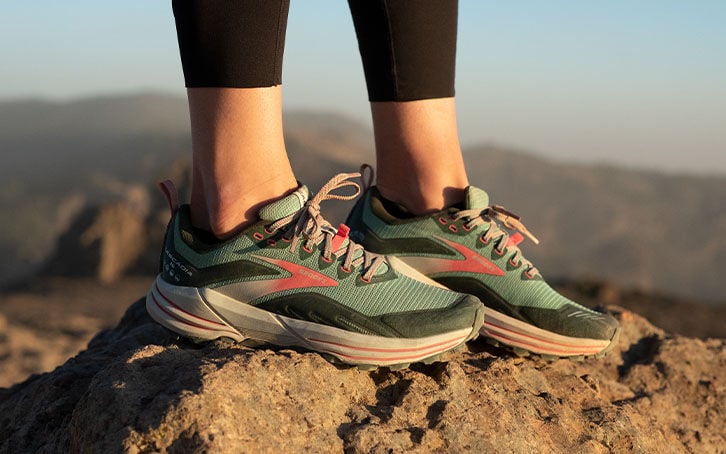
Road vs. Trail Running Shoes
The surface you run along also dictates the features your running sneakers should have. In this respect, the running shoe industry offers road shoes and trail shoes.
Since manufacturers justly assume that a road doesn’t vary much, they focus more on corrective features discussed above, such as arch support for over-pronators and supinators. Road shoes tend to be lightweight, breathable, and flexible for superior performance on hard, even surfaces.
Trail-running shoes, on the other hand, are built for heavy-duty use. They are a lot stiffer than road shoes to provide support on rugged and uneven terrains and feature toe protection and rock plates. Unlike shoes for pavement, which have smooth outsoles, trail shoes have deep lugs and sticky treads for a better grip on rock, mud, snow, or water.
Regardless of all running shoe innovations, you’re unlikely to find a shoe that rules them all. Big brands like Brooks do manufacture all-in-one models, but it doesn’t mean they can handle road and trail tasks as efficiently as purposefully-built designs do.
Traction
When we talk about traction, we should consider the outsole material, geometry, and lug depth.
There’s a good analogy regarding how different materials work with various surfaces - automobile tires. Summer tires are made of firmer rubber that grips better on dry surfaces, while softer rubber on winter tires promotes better traction on ice and snow.
Generally, harder outsoles, such as those made of carbon rubber, are found on road shoes for dry weather and clean sidewalks. In contrast, blown rubber is softer and provides a better grip on slippery surfaces. You’ll also find shoes with EVA foam outsoles. Foam provides adequate grip on dry and wet roads, but they don’t work as well with slush and smooth artificial floors that are waxed or dusty.
Now, what about tread patterns? As a rule of thumb, outsoles with small, deep lugs grip better. However, grippy shoes with a flat geometry exist, but the geometry is balanced with high-tech rubber compounds.
When choosing trail running shoes, look for a geometry that divides the outsole into separate sections. These sections will work independently and provide traction only when necessary, without clogging. Also, if the count of lugs is high and the lugs are long, they need to be spaced wider.
Sizing & Fitting Running Shoes
Here are several tips to get a perfect fit.
- Measure the length and width of BOTH feet because they are often not the same size; go with the larger size. When in a store, try on both shoes.
- Measure your feet wearing the same gear (socks, braces, and orthotics) you would wear when running. Also, bring along your special running insoles, if any.
- Measure your feet at the end of the day because they get a little bigger.
- Remember that the toe box should be snug, but you should still be able to move your toes.
- Refer to the sizing chart of the brand you want to choose.
- Learn techniques for lacing running shoes since it can improve the fit. For instance, the runner’s loop is used to lock the heel in place and prevent toes from bumping against the front of the shoes. If you feel pressure on the top of your feet, try window lacing, aka box lacing, to relieve it.
- Don’t forget that running shoes need breaking in. It won’t take long if you’ve purchased the same pair as your previous shoes. Otherwise, it’s not the shoes that need breaking in but your body to get accustomed to a new feel. Usually, a healthy transition period is about two weeks. During this time, walk in your new shoes with thicker socks on and make short runs.
Conclusion
As you see, choosing the best running shoes for your needs isn’t easy because of all these things you should keep in mind. But at least now you know what to pay attention to - pronation type, running style, surface, etc. So we welcome you to apply your freshly gained knowledge here, on RunUnited. We’ve collected some of the greatest running shoes for men and women made by such brands as Brooks, Saucony, Fila, and others. You can also come to our brick-and-mortar store, where our experienced assistants will pick an ideal shoe for you.
EXPLORE POPULAR ARTICLES
-
Run Bright, Stay in Sight: Reflective Gear for Night Running
Dec 10th 2025When winter comes, the days get shorter, and the sun sets before we’re done with our day. If you’re
-
Saucony Ride vs Brooks Ghost: Choosing a Daily Trainer
Dec 3rd 2025In this post, we’re comparing two good daily running shoes - the Saucony Ride 18 and Brooks Ghost 17
-
Adrenaline vs. Glycerin: Comparing Brooks Stability Shoes
Nov 19th 2025Here, we briefly compare two popular Brooks overpronation running shoes - Adrenaline GTS vs Glycerin





